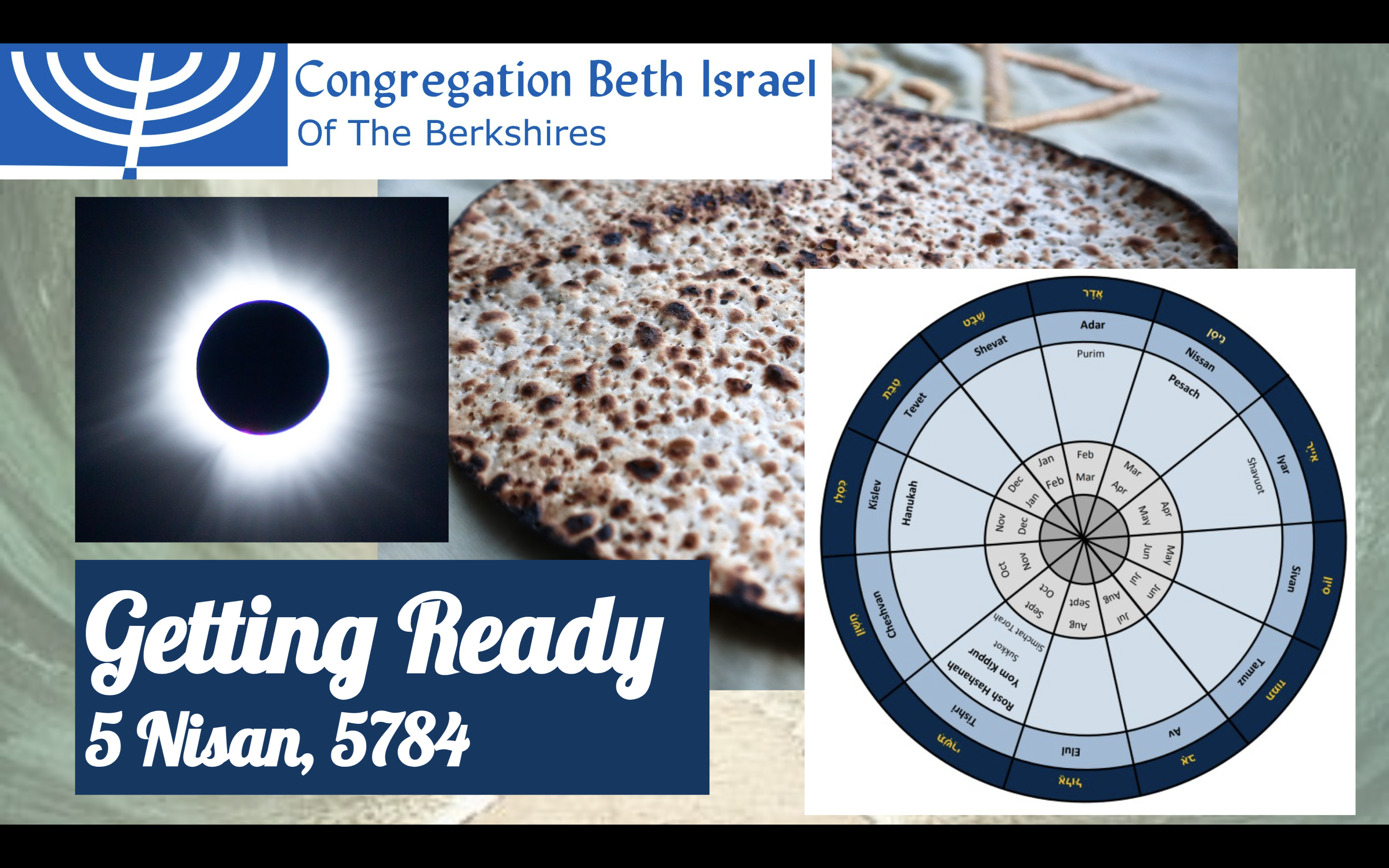On Monday a group gathered at CBI for the eclipse. When we were down to a thin golden crescent of sun, the light became bronzed and strange. The spring peepers were loudly singing their twilight song, the one we hear at seder when we open the door to recite, “This is the bread of affliction that our ancestors ate in the land of Egypt…” When the sun began to grow, the peepers all stopped singing in the same instant, as if hushed by a celestial conductor.
The morning after the eclipse was Rosh Hodesh Nisan, the start of a new lunar month — just two weeks until Pesach. Rosh Hodesh Nisan is one of the four times in the year the Talmud calls a new year, and it may be the oldest one. It makes a certain kind of sense to begin a new year in the spring, harnessing the spiritual energy of blooms and leaves along with the spiritual energy of the Exodus, the core story that makes us who we are.
The fact that it’s now Nisan also means we’re at the midpoint of the Jewish year, halfway through 5774. Three weeks into this Jewish year, when we were just about to finish the Jewish holiday marathon, came October 7. The war and ensuing humanitarian disaster have compounded our heartbreak several times over. Time has felt out of joint. But here we are. It’s time to get ready for Pesach, which means it’s time for both outward and inward spring cleaning.
The outward cleaning is pretty straightforward. Tradition teaches us to rid our kitchens (for a week) of חמץ / hametz, that which is leavened or can become so: wheat, oats, barley, rye, and spelt. Hametz is related to חָמוּץ / sour: hametz is something that could become fermented. (Think sourdough starter.) Spiritually, hametz is often understood as the puffery of ego and self-importance, or old stories that no longer serve, or stale habits we need to release.
Searching for and discarding inner hametz is the mid-year course correction work. We ask ourselves: where did I intend to go, this year? (Not geographically, but spiritually.) Who did I intend to be? What adjustments do I need to make to get back on track?
This year, the question that keeps coming up is: how do we prepare for Pesach after everything we’ve witnessed and felt over the last six months? Our collective hearts are broken. It’s different from the individual grief of a personal loss. I’ve been thinking about how we are not the first generation to celebrate Pesach during a difficult time. The story of moving from Mitzrayim to freedom was a beacon and a comfort for our ancestors. It can be that for us, too.
Pesach is a communal story of a people – Torah says an erev rav, a mixed multitude – emerging into freedom. This year I’m extra-aware that we’re a mixed multitude. The joke is, “two Jews, three opinions,” but when it comes to Israel and Palestine the Jewish community is literally all over the map. Jews are at the forefront of fighting in Gaza, and at the forefront of calls for a ceasefire.
Can we discard as hametz our stereotypes of each other? If we could do that, what new conversations might we have about what it means to be a Jew in relationship with that beloved land and its inhabitants? Can we step into those waters and trust that we won’t drown?
Pesach is also a personal story. As Torah teaches (Ex. 13:8), “You shall tell your child on that day, this is because of what God did for me when God brought me out of Egypt.” This isn’t an either/or. Pesach is a communal story of rebirth and peoplehood, and an opportunity to feel ourselves lifted free from constriction.
Inner preparation for Pesach means letting go of what’s keeping us stuck, and affirming our agency to act. We may not be able to change world events. We may not be able to change a diagnosis, or a loss. But we can change how we respond. We can change ourselves.
I return often to the teaching I received from Jason Shinder z”l: “Whatever gets in the way of the work, is the work.” (And he got it from Sophie Cabot Black.) He was talking about revising poetry, but it’s true about revising the poem of the self, too. What’s getting in our way? What old stories are holding us back? Our answers point to the hametz we need to discard this year. And sometimes it’s the same hametz we thought we tossed last year or the year before, because the journey of the spirit isn’t linear.
Now is the time for letting go of what no longer serves. We could do that anytime. But habits and patterns tend to be self-sustaining, and human beings mostly don’t change on our own. Which is maybe why our tradition gives us opportunities each year, in early fall and in early spring, to tackle this inner work singly and together. We’re each doing our own inner work of seeking and discarding hametz, but we find renewed strength in all doing it at the same time.
On the day of the eclipse, the peepers’ song made me feel a foretaste of the spiritual urgency of seder. And then hearing them stop, as though God had hit a mute button, left me awestruck. I don’t know how they fall silent all at once. Maybe something in them is naturally aligned and connected – like the way a vast flock of birds can take off at once, or a school of hundreds of fish swims in perfect parallel.
I wouldn’t want us to all be in lockstep. Like our ancient ancestors, we’re a mixed multitude, and I believe there’s both strength and wisdom in our diversity. And yet – as our choir could tell you – there is beauty and meaning in lifting our voices together. This is my favorite metaphor for community. We’re not all the same. If we were, there would be no harmony. But we’re aligned, and working together to make something greater than the sum of its parts.
May our inner and outer preparations for Pesach help our souls become more aligned – not the same, but part of a greater whole – so that when seder comes, we’re all as ready as we can be to move out of Mitzrayim together.
This is the d’var Torah that Rabbi Rachel offered at Kabbalat Shabbat services (cross-posted to Velveteen Rabbi.)






